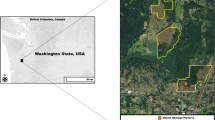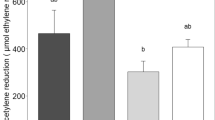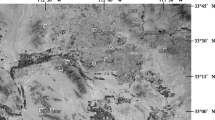Abstract
The impact of reduced light conditions as an indirect effect of nitrogen (N) deposition was determined on three mosses in a montane ecosystem, where sedge and grass cover increase due to N enrichment. Additionally, in the greenhouse we established the importance of low light to moss growth as an indirect N deposition effect relative to the direct toxic effects of N. The amount of light reaching the moss layer was strongly and negatively related to graminoid abundance. Mosses showed differing sensitivities to reduced light in the field. Racomitrium lanuginosum biomass was found to be highest under high-light conditions, Polytrichum alpinum at intermediate light levels, whilst that of Dicranum fuscescens was unrelated to light availability. Moreover, Racomitrium biomass decreased with increasing amounts of graminoid litter, whereas the other species were little affected. All three mosses responded differently to the combination of elevated N (20 vs 10 kg N ha−1 year−1) and reduced light (60 and 80% reduction) in the greenhouse. Racomitrium growth was strongly influenced by both light reduction and elevated N, in combination reducing shoot biomass up to 76%. There was a tendency for Dicranum growth to be modestly reduced by elevated N when shaded, causing up to 19% growth reduction. Polytrichum growth was not influenced by elevated N but was reduced up to 40% by shading. We conclude that competition for light, induced by vascular plants, can strongly influence moss performance even in unproductive low biomass ecosystems. The effects of reduced light arising from N pollution can be as important to mosses as direct toxicity from N deposition. Yet, different sensitivities of mosses to both toxic and shading effects of elevated N prevent generalisation and can lead to competitive species replacement within moss communities. This study demonstrates the importance of understanding moss-vascular plant interactions to allow interpretation and prediction of ecosystem responses to anthropogenic drivers such as atmospheric N deposition or climate change.




Similar content being viewed by others
References
Aerts R, Bobbink R (1999) The impact of atmospheric nitrogen deposition on vegetation processes in terrestrial, non-forest ecosystems. In: Langan S (ed) The impact of nitrogen deposition on natural and semi-natural ecosystems. Kluwer, Dordrecht, pp 85–122
Bakken S (1995) Effects of nitrogen supply and irradiance on growth and nitrogen status in the moss Dicranum majus from differently polluted areas. J Bryol 18:707–721
Bardgett RD, Streeter TC, Cole L, Hartley IR (2002) Linkages between soil biota, nitrogen availability, and plant nitrogen uptake in a mountain ecosystem in the Scottish Highlands. Appl Soil Ecol 19:121–134
Bates JW (2000) Mineral nutrition, substratum ecology, and pollution. In: Shaw AJ, Goffinet B (eds) Bryophyte biology. Cambridge University Press, Cambridge, pp 248–311
Belcher JW, Keddy PA, Twolan-Strutt L (1995) Root and shoot competition intensity along a soil depth gradient. J Ecol 83:673–682
Bergamini A, Pauli D (2001) Effects of increased nutrient supply on bryophytes in montane calcareous fens. J Bryol 23:331–339
Bergamini A, Peintinger M (2002) Effects of light and nitrogen on morphological plasticity of the moss Calliergonella cuspidata. Oikos 96:355–363
Bergamini A, Pauli D, Peintinger M, Schmid B (2001) Relationships between productivity, number of shoots and number of species in bryophytes and vascular plants. J Ecol 89:920–929
Bunce RGH, Smart SM, Van de Poll HM, Watkins JW, Scott WA (1999) Measuring change in British vegetation. Department of Environment, Transport and Regions, London
Carroll JA, Johnson D, Morecroft M, Taylor A, Caporn SJM, Lee JA (2000) The effect of long-term nitrogen additions on the bryophyte cover of upland acidic grasslands. J Bryol 22:83–89
Cornelissen JHC et al. (2001) Global change and arctic ecosystems: is lichen decline a function of increases in vascular plant biomass? J Ecol 89:984–994
DeLuca TH, Zackrisson O, Nilsson MC, Sellstedt A (2002) Quantifying nitrogen-fixation in feather moss carpets of boreal forests. Nature 419:917–920
Dirkse GM, Martakis GFP (1992) Effects of fertilizer on bryophytes in Swedish experiments on forest fertilization. Biol Conserv 59:155–161
Dormann CF, Woodin SJ (2002) Climate change in the Arctic: using plant functional types in a meta-analysis of field experiments. Funct Ecol 16:4–17
Eddy A, Welch D, Rawes M (1969) The vegetation of the Moor House national nature reserve in the northern Pennines, England. Vegetatio 16:239–284
Fowler D, Cape JN, Leith D (1988) The influence of altitude on rainfall composition at Great Dunn Fell. Atmos Environ 22:1355–1362
Gordon C, Wynn JM, Woodin SJ (2001) Impacts of increased nitrogen supply on high Arctic heath: the importance of bryophytes and phosphorus availability. New Phytol 149:461–471
Grubb PJ (1985) Plant populations and vegetation in relation to habitat disturbance and competition; problems and generalisation. In: White J (ed) The population structure of vegetation. Junk, Dordrecht, pp 595–611
Hill MO, Preston CD, Smith AJE (eds) (1992) Atlas of the bryophytes of Britain and Ireland. Harley Books, Colchester
Hobbie SE (1996) Temperature and plant species control over litter decomposition in Alaskan tundra. Ecol Monogr 66:503–522
Huisman J, Weissing FJ (2001) Fundamental unpredictability in multispecies competition. Am Nat 157:488–494
Huisman J, Grover JP, Van der Wal R, Van Andel J (1999a) Competition for light, plant species replacement, and herbivory along productivity gradients. In: Olff H, Brown VK, Drent RH (eds) Herbivores: between plants and predators. Blackwell, Oxford, pp 239–269
Huisman J, Jonker RR, Zonneveld C, Weissing FJ (1999b) Competition for light between phytoplankton species: experimental tests of mechanistic theory. Ecology 80:211–222
Jefferies RL, Maron JL (1997) The embarrassment of riches: atmospheric deposition of nitrogen and community and ecosystem processes. Trends Ecol Evol 12:74–78
Jónsdóttir IS, Callaghan TV, Lee JA (1995) Fate of added nitrogen in a moss-sedge Arctic community and effects of increased nitrogen deposition. Sci Tot Environ 160/161:677–685
Kull O, Aan A, Soelsepp T (1995) Light interception, nitrogen and leaf mass-distribution in a multilayer plant community. Funct Ecol 9:589–595
Lee JA (1998) Unintentional experiments with terrestrial ecosystems: ecological effects of sulphur and nitrogen pollutants. J Ecol 86:1–12
Li YH, Vitt DH (1997) Patterns of retention and utilization of aerially deposited nitrogen in boreal peatlands. Ecoscience 4:106–116
Littell RC, Milliken GA, Stroup WW, Wolfinger RD (1996) SAS systems for mixed models. SAS, Cary
Mäkipää R (1998) Sensitivity of understorey vegetation to nitrogen and sulphur deposition in a spruce stand. Ecol Eng 10:87–95
McVean DN, Ratcliffe DA (1962) Plant communities of the Scottish Highlands. HMSO, London
Morecroft MD, Sellers EK, Lee JA (1994) An experimental investigation into the effects of atmospheric nitrogen deposition on 2 seminatural grasslands. J Ecol 82:475–483
Newman EI (1973) Competition and diversity in herbaceous vegetation. Nature 244:310
O’Neill KP (2000) Role of bryophyte-dominated ecosystems in the global carbon budget. In: Shaw A, Goffinet B (eds) Bryophyte biology. Cambridge University Press, Cambridge, pp 344–368
Pearce ISK, Van der Wal R (2002) Effects of nitrogen deposition on growth and survival of montane Racomitrium lanuginosum heath. Biol Conserv 104:83–89
Pearce ISK, Woodin SJ, Van der Wal R (2003) Physiological and growth responses of the montane bryophyte Racomitrium lanuginosum to atmospheric nitrogen deposition. New Phytol 160:145–155
Pedersen B, Hanslin HM, Bakken S (2001) Testing for positive density-dependent performance in four bryophyte species. Ecology 82:70–88
Press MC, Potter JA, Burke MJW, Callaghan TV, Lee JA (1998) Responses of a subarctic dwarf shrub heath community to simulated environmental change. J Ecol 86:315–327
Proctor MCF (2000) Physiological ecology. In: Shaw A, Goffinet B (eds) Bryophyte ecology. Cambridge University Press, Cambridge, pp 225–247
Rodwell JS (1992) British plant communities, vol 3. Grasslands and montane communities. Cambridge University Press, Cambridge
Shaw AJ, Goffinet B (eds) (2000) Bryophyte biology. Cambridge University Press, Cambridge
Smith AJE (1978) The moss flora of Britain and Ireland. Cambridge University Press, Cambridge
Thompson DBA, Baddeley JA (1991) Some effects of acidic deposition on montane Racomitrium lanuginosum heaths. In: Woodin SJ, Farmer AM (eds) The effects of acid deposition on nature conservation in Great Britain. Focus on nature conservation, No. 26. Nature Conservancy Council, Peterborough, pp 17–28
Thompson DBA, Brown A (1992) Biodiversity in montane Britain—habitat variation, vegetation diversity and some objectives for conservation. Biodivers Conserv 1:179–208
Tilman D (1988) Plant strategies and the dynamics and structure of plant communities. Princeton, New Jersey
Tilman D (1990) Mechanisms of plant competition for nutrients: the elements of a predictive theory of competition. In: Grace JB, Tilman D (eds) Perspectives on plant competition. Academic, New York
Uchida M, Muraoka H, Nakatsubo T, Bekku Y, Ueno T, Kanda H, Koizumi H (2002) Net photosynthesis, respiration, and production of the moss Sanionia uncinata on a glacier foreland in the High Arctic, Ny-Ålesund, Svalbard. Arctic, Antarct Alp Res 34:287–292
Van der Wal R, Brooker RW (2004) Mosses mediate grazer impacts on grass abundance in arctic ecosystems. Funct Ecol 18:77–86
Van der Wal R, Egas M, Van der Veen A, Bakker J (2000) Effects of resource competition and herbivory on plant performance along a natural productivity gradient. J Ecol 88:317–330
Van der Wal R, Pearce ISK, Brooker R, Scott D, Welch D, Woodin SJ (2003) Interplay between nitrogen deposition and grazing causes habitat degradation. Ecol Lett 6:141–146
Virtanen R, Johnston AE, Crawley MJ, Edwards GR (2000) Bryophyte biomass and species richness on the Park Grass Experiment, Rothamsted, UK. Plant Ecol 151:129–141
Vitousek PM, Mooney HA, Lubchenco J, Melillo JM (1997) Human domination of Earth’s ecosystems. Science 277:494–499
Weiner J (1990) Asymmetric competition in plant populations. Trends Ecol Evol 5:360–364
Woodin SJ, Lee JA (1987) The effects of nitrate, ammonium and temperature on nitrate reductase activity in Sphagnum species. New Phytol 105:103–105
Zimov SA, Chuprynin VI, Oreshko AP, Chapin FS, Reynolds JF, Chapin MC (1995) Steppe-tundra transition: a herbivore driven biome shift at the end of the Pleistocene. Am Nat 146:765–794
Zogg GP, Zak DR, Pregitzer KS, Burton AJ (2000) Microbial immobilization and the retention of anthropogenic nitrate in a northern hardwood forest. Ecology 81:1858–1866
Acknowledgements
We are grateful to Invercauld Estate for access to Glas Maol, and to Louise Newell, Jennifer Goodlad, Emily Clarke and Louise Ross for assisting with the field and laboratory work. Steve Albon, Andy McMullen, Dave Scott, David Welch and two anonymous referees provided valuable comments to earlier versions of the paper. Part of the study was funded by the National Environment Research Council (NER/B/S/2000/00053).
Author information
Authors and Affiliations
Corresponding author
Rights and permissions
About this article
Cite this article
van der Wal, R., Pearce, I.S.K. & Brooker, R.W. Mosses and the struggle for light in a nitrogen-polluted world. Oecologia 142, 159–168 (2005). https://doi.org/10.1007/s00442-004-1706-0
Received:
Accepted:
Published:
Issue Date:
DOI: https://doi.org/10.1007/s00442-004-1706-0




